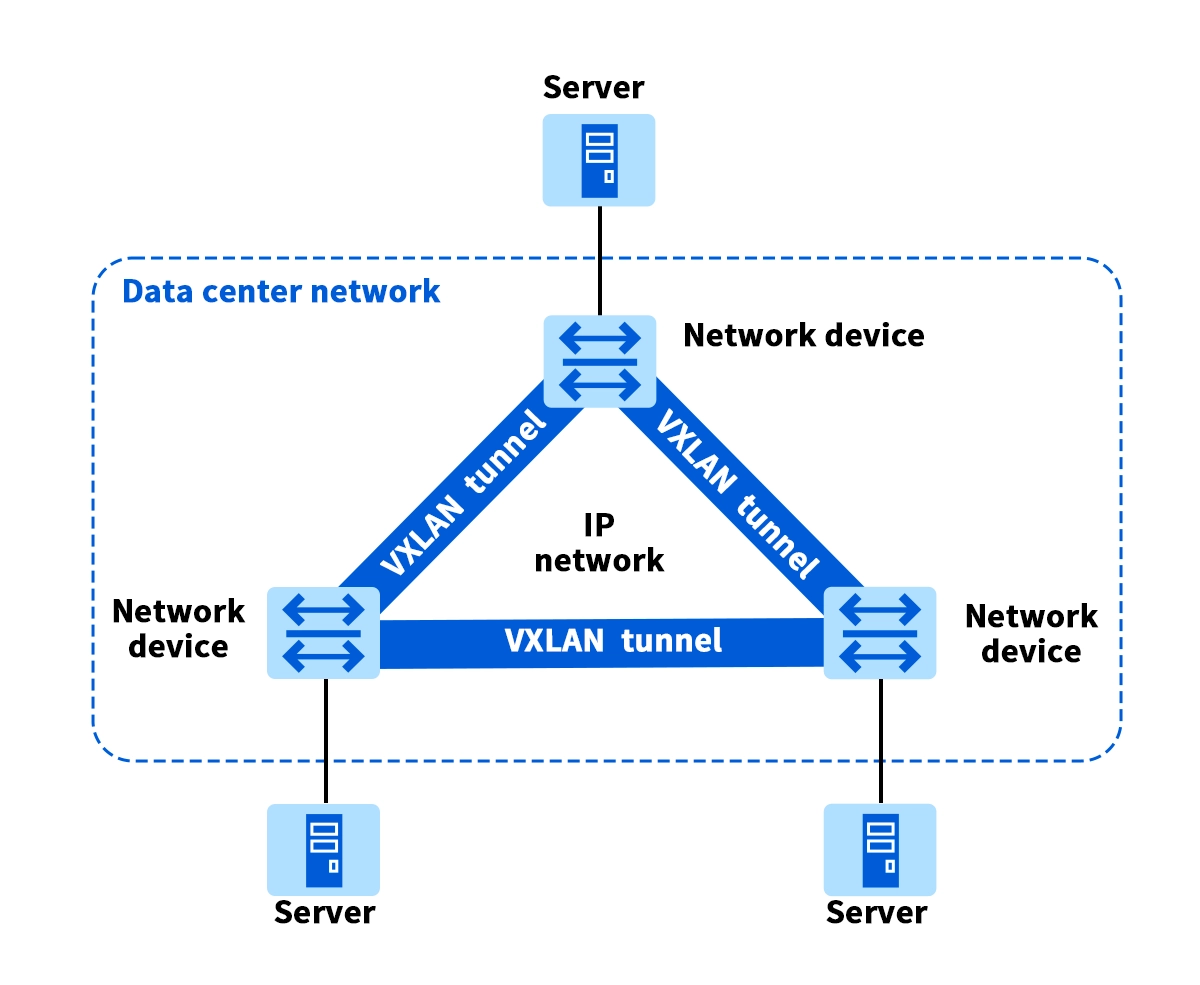
In an era defined by cloud computing, big data, and ubiquitous connectivity, traditional network architectures are straining under the pressure. The 4096-VLAN limit and the constraints of Layer 2 domains are no longer sufficient for massive, dynamic, and multi-tenant environments. Enter VXLAN (Virtual Extensible LAN), a revolutionary network virtualization technology that is reshaping how we build scalable and agile networks.
This comprehensive guide will unpack what VXLAN is, how it works, its critical benefits, and why choosing the right hardware, including high-performance LINK-PP optical transceivers, is paramount for a successful implementation. Let's dive in.
📝 Key Takeaways
VXLAN lets you make a big network with up to 16 million segments. This is much more than the 4096 segments in regular VLANs. This helps your data center grow easily.
With VXLAN, you can link devices in different data centers. You do not need to change your current network. This makes sure your services keep running even if there are problems.
Every virtual network in VXLAN has its own identifier. This keeps data separate and safe. You can manage many teams or customers in one place without worry.
VXLAN lets you set up networks quickly. You can use host-based, gateway-based, or hybrid setups. Pick the one that works best for your data center.
You need to plan well for VXLAN to work right. Make sure your hardware works with VXLAN. Test your network to stop problems before you set it up.
📝 What is VXLAN? A High-Level Overview
VXLAN, or Virtual Extensible LAN, is an encapsulation protocol that allows you to create overlay networks. Think of it as a "network within a network." It runs over your existing physical IP network (the underlay) but creates logical, isolated Layer 2 segments that can span across physical boundaries, even over vast geographical distances.
The primary goal? To overcome the scalability limitations of traditional VLANs. While VLANs use a 12-bit identifier, limiting you to about 4094 unique networks, VXLAN uses a 24-bit VXLAN Network Identifier (VNI). This translates to a staggering 16 million unique segments! This massive scale is essential for modern cloud providers and large enterprises.
📝 How Does VXLAN Work? The Magic of Encapsulation
The core of VXLAN's functionality lies in encapsulation. It takes an original Layer 2 Ethernet frame, wraps it in a VXLAN header, and then places that inside a standard UDP-IP packet. This new packet can then be routed across your IP network just like any other IP packet.
The key components in a VXLAN setup are:
VTEP (VXLAN Tunnel Endpoint): This is the star of the show. A VTEP is the device that performs the encapsulation and de-encapsulation. It can be a physical switch, a hypervisor vSwitch, or a router. Each VTEP has two interfaces: an IP interface in the underlay network and a logical interface into the VXLAN overlay.
VNI (VXLAN Network Identifier): The 24-bit segment ID that identifies the specific overlay network.
Underlay Network: The physical IP fabric (often a spine-leaf architecture) that is responsible for transporting the encapsulated VXLAN packets.

Here's a simplified step-by-step process:
Frame Origination: A virtual machine sends a standard Ethernet frame destined for another VM in the same VXLAN segment but on a different physical host.
Encapsulation: The source VTEP encapsulates the entire Layer 2 frame with a VXLAN header (which contains the VNI) and a UDP-IP header. The source and destination IP addresses in this new packet are the IPs of the VTEPs themselves.
Transport: This newly created UDP packet is routed through the underlay IP network.
De-encapsulation: The destination VTEP receives the packet, strips off the UDP-IP and VXLAN headers, and delivers the original Ethernet frame to the target VM.
This process allows Layer 2 connectivity to be extended over a Layer 3 network, making the underlying topology irrelevant to the virtual machines.
📝 VXLAN vs. VLAN: A Head-to-Head Comparison
Why migrate from the well-established VLAN? The following table highlights the key differences that make VXLAN the superior choice for large-scale, dynamic environments.
Feature | Traditional VLAN | VXLAN (Overlay Network) |
|---|---|---|
Scale Limit | ~4094 VLANs | ~16 Million VNIs |
Spanning Tree Protocol | Often required, can lead to blocked links | Avoided; uses efficient Layer 3 routing in the underlay |
Network Scope | Limited to a single Layer 2 domain | Can span across Layer 3 boundaries, ideal for multi-site data center connectivity |
MAC Address Table | Consumed on all switches in the VLAN | Contained within VTEPs; reduces burden on physical hardware |
Use Case | Small to medium enterprises, static networks | Large data centers, cloud environments, network virtualization for multi-tenancy |
📝 Key Benefits and Why VXLAN is a Game-Changer
Adopting VXLAN brings transformative advantages to your network infrastructure:
Massive Scalability: With 16 million segments, you can confidently support massive multi-tenancy without fearing ID exhaustion.
Optimal Workload Placement: Decouple the logical network from the physical. You can place VMs anywhere in the data center, enabling flexible workload mobility and efficient resource utilization.
Enhanced Network Utilization: By leveraging a Layer 3 underlay (like a Clos network), you can use all available paths, eliminating the inefficiencies of Spanning Tree Protocol.
Improved Security and Isolation: Each VNI provides strong isolation, similar to a VLAN but at a much larger scale, which is perfect for securing tenant environments in cloud deployments.
📝 The Role of Optical Transceivers in a High-Performance VXLAN Fabric
A robust VXLAN overlay is only as strong as its underlay. The underlay network demands high bandwidth, low latency, and extreme reliability to handle the additional encapsulation overhead without becoming a bottleneck. This is where high-quality optical transceivers become critical.
Optical transceivers are the workhorses that convert electrical signals to light and back, facilitating high-speed data transmission over fiber optic cables. In a dense spine-leaf architecture running VXLAN, the inter-switch links (ISLs) carry a massive amount of encapsulated traffic. Using subpar transceivers can lead to packet loss, increased latency, and jitter, severely degrading the performance of your overlay networks.
For a seamless VXLAN implementation guide and optimal performance, it's essential to partner with a reliable hardware provider. LINK-PP offers a range of compatible, high-performance optical transceivers engineered for such demanding environments. A perfect fit for 25G or 100G spine-leaf connections in a modern data center is the LINK-PP SFP28-25G-LR and LINK-PP QSFP28-100G-LR4 modules.
LINK-PP SFP28-25G-LR: Ideal for 25Gigabit Ethernet connections, providing up to 10km reach with low power consumption and superior stability.
LINK-PP QSFP28-100G-LR4: A high-density 100GbE transceiver that supports links up to 10km, perfect for the core spine links aggregating traffic from hundreds of VTEPs.
Integrating LINK-PP transceivers ensures your VXLAN underlay has the necessary throughput and reliability, providing a solid foundation for your virtualized network overlays. When planning your data center network architecture, never underestimate the importance of quality optics.
📝 Getting Started with VXLAN: Key Considerations
Implementing VXLAN might seem daunting, but you can break it down into manageable steps:
Design a Robust Underlay: Build a highly available, low-latency IP fabric (typically spine-leaf).
Choose Your Control Plane: Decide between manual configuration (inefficient at scale) or a dynamic control plane like EVPN (Ethernet VPN), which is the industry best practice for automating VXLAN deployment.
Select Compatible Hardware: Ensure your switches, routers, and hypervisors support VXLAN and have the processing power for encapsulation duties. Don't forget to source reliable optics from trusted vendors like LINK-PP.
📝 Conclusion: Future-Proof Your Network with VXLAN
VXLAN is no longer a niche technology; it's the foundation for the next generation of agile, scalable, and secure networks. By decoupling the network service layer from the physical infrastructure, it offers unparalleled flexibility for cloud, data center, and even enterprise WAN scenarios.
Understanding the benefits of VXLAN over traditional networks is the first step. The next is building a high-performance foundation to support it.
📝 FAQ
What is a VXLAN tunnel endpoint (VTEP)?
A VTEP is a device or software that wraps your network data in VXLAN packets. You use VTEPs to send and receive traffic between different parts of your virtual network.
What makes VXLAN better than VLAN for large networks?
VXLAN lets you create millions of segments. You can grow your network much bigger than with VLAN. You also keep different groups and data separate.
What do you need to set up VXLAN in your data center?
You need switches or servers that support VXLAN. You also need a plan for overlays and VTEPs. Test your setup before you use it for important work.
What problems can you face when using VXLAN?
You may need new hardware. You must manage overlays and VTEPs. Troubleshooting can take more time because of the extra layer. Good planning helps you avoid most issues.


